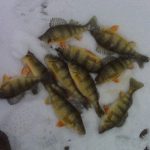
In New York, the weekend of February 15-16, 2020, is a designated free fishing weekend.
The requirement for a fishing license is waived during this period, making it a great opportunity to try ice fishing for the first time or for experienced anglers to take loved ones ice fishing for the first time.
According to the New York State Department of Environmental Conservation (DEC) the state’s winter free fishing weekend offers anglers with an opportunity to enjoy ice fishing while spending time with family and friends outdoors during the winter months.
“Ice fishing continues to increase in popularity in New York and there are great opportunities to enjoy this winter sport across the state,” said Commissioner Basil Seggos. “From plentiful panfish to trophy tiger muskies, many fish species are active throughout the winter and the fishing can be just as good as during the open water season. Before venturing onto the ice, anglers should be cautious and make sure ensure the ice is thick enough to fish safely.”
Four inches of solid clear ice is usually safe for anglers accessing ice on foot. Ice thickness can vary on waterbodies and even within the same waterbody.
Anglers should be particularly cautious of areas of moving water and around boat docks and houses where bubblers may be installed to reduce ice from forming.
Testing the ice can easily be done with an auger or spud bar at various spots. Fishing with a family member or a friend is also encouraged for safety.
New Yorkers interested in learning how to ice fish are encouraged to visit DEC’s free fishing clinics webpage. Participation in these programs do not require a fishing license and equipment is often provided for use.
Beginning ice anglers are encouraged to download the Ice Fishing Chapter (PDF) of DEC’s I FISH NY Beginners’ Guide to Freshwater Fishing for information on how to get started ice fishing.
Additional information, including a list of waters open to ice fishing, can be found on the DEC ice fishing web page (https://www.dec.ny.gov/outdoor/7733.html).
source: New York State Department of Environmental Conservation